What Pontoon Trailer is Right for You?
Regular Duty Single Axle Pontoon Trailers
Our Regular Duty Single Axle Trailers are perfect for 16ft-22ft pontoons. These pontoon trailers are built with 4inX2in 11 gauge steel tube frames and 3inX2in14 gauge cross braces to support up to a 2,570 # load. These pontoon trailers come standard with a 14in wide step ladder with a handrail and winch, Double Wheel folding tongue jack, molded plastic fenders, LED Lights with Protective Steel Tail Light Housing, four leaf springs, a custom self-grounding wire harness, and 13in radial tires.
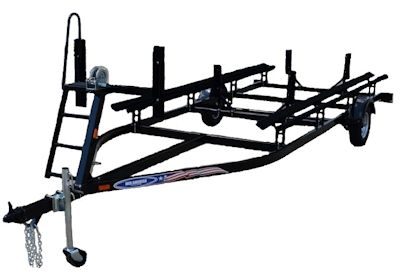
*You may notice certain pontoon trailer lengths are available in both options, such as both single axle and tandem axle. When determining which one is best for you, there are a few questions you should consider.
1.) Are you going to be traveling with your pontoon? If so, how often and how far?- If the answer is yes, pretty often, or a fair distance a tandem axle would be your safest bet. Furthermore, when traveling you will also want to look into your brake options. Adding brakes to your pontoon trailer will insure you have a much smoother and safer journey. Please also check your states brake laws, as the law sometimes differs between states.
2.) What size motor is on your pontoon?- When your pontoon has a bigger motor, it adds a lot of extra weight to your pontoon. Tandem axle trailers can hold more weight that a single axle trailer. Be sure to look into the holding capacity of the trailer when making your decision. When calculating how much your motor weighs, typically it would be approximately 4 pounds per HP. However, you should always check with the manufacturer to be safe.
Regular Duty Tandem Axle Pontoon Trailers
Our Regular Duty Tandem Axle Trailers are our most popular trailers! These are perfect for 20ft to 26ft pontoons. These pontoon trailers are built with 4inX2in 11 gauge steel tube frame and 3inX2in 14 gauge cross braces to support up to a 4,000# load. These trailers come standard with a 14in wide step ladder with a handrail and winch, Double Wheel folding tongue jack, contour metal fenders, LED Lights with Protective Steel Tail Light Housing, four leaf springs, a custom self-grounding wire harness, and 13in radial tires.
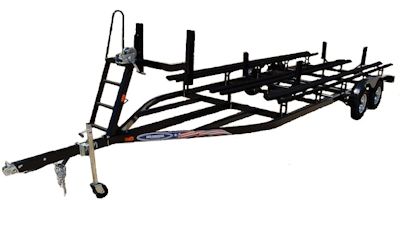
Some pontoon trailers are even available in both Regular Duty Tandem Axle and Heavy Duty Tandem Axle. When determining which one is best for you, there are a few questions you should consider.
1.) Are you going to be traveling with your pontoon? If so, how often and how far?- If the answer is yes, pretty often, or a fair distance a Heavy Duty might be your best option. Pontoons that are between 24ft and 26ft in size are pretty large boats, and if you choose a Heavy Duty trailer they come standard with not only a thicker frame but also brakes on both axles. If you dont think your pontoon is as heavy and doesnt require brakes on both axles, you may be able to get a tandem axle with brakes on just on axle. Remember, a Regular Duty can hold up to 4,050# and a Heavy Duty can hold up to 5,800#.
2.) What size motor is on your pontoon?- When your pontoon has a bigger motor, it adds a lot of extra weight to your pontoon. Be sure to look into the holding capacity of the trailer when making your decision.
3.) Is your pontoon a bi-toon or a tri-toon?- Again your going to want to look into the holding capacity of your trailer, as a third toon can really effect the weight of your trailer.
Heavy Duty Tandem Axle Pontoon Trailers
Our Heavy Duty Tandem Axle Trailers are perfect for those of you who not only have a larger heavier boat, but also for those of you who plan on traveling with your boat. These pontoon trailers are built with 5inX2in 11 gauge steel tube frames and 3inX2in 14 gauge cross braces to support up to a 5,800# load. Our Heavy Duty trailers come standard with brakes on both axels, 14in wide step ladder with a handrail and winch, Double Wheel folding tongue jack, molded plastic fenders, LED Lights with Protective Steel Tail Light Housing, four leaf springs, a custom self-grounding wire harness, and 14in radial tires.
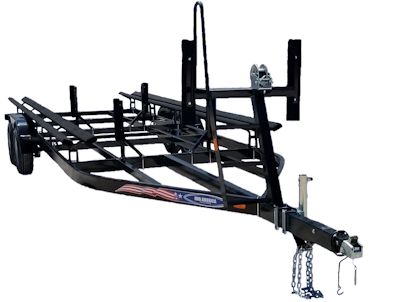
Super Duty Triple Axle Pontoon Trailers
Our Super Duty Triple Axle Trailers are perfect for 28ft-34ft pontoons or house boats. These trailers are built with 5in 11 gauge steel tube frames and 3inX2in 14 gauge cross braces to support up to a 8,500# load! Our Super Duty trailers come standard with brakes on two axels, 14in wide step ladder with a handrail and winch, Double Wheel folding tongue jack, molded plastic fenders, LED Lights with Protective Steel Tail Light Housing, four leaf springs, a custom self-grounding wire harness, and 14inradial tires.
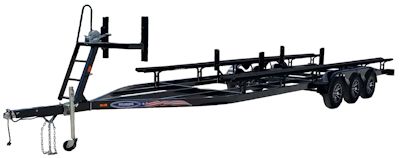
If you have a 28ft Boat your options are a Heavy Duty Tandem Axle Pontoon Trailer, or a Super Duty Triple Axle Pontoon Trailer.
1.) Are you going to be traveling with your pontoon? If so, how often and how far?- A 28ft Long boat Is going to be pretty heavy, so if your traveling more than just to put your boat in and out of storage, you may want to opt for the Super Duty Triple Axle, which is standard with brakes on two axles and can hold up to 8,500#. If your just traveling short distances, or hardly traveling at all, Heavy Duty Tandem Axle would be the way to go.
2.) What size motor is on your pontoon?- When your pontoon has a bigger motor, it adds a lot of extra weight to your pontoon. Be sure to look into the holding capacity of the trailer when making your decision.
3.) Is your pontoon a bi-toon or a tri-toon?- Going back to holding capacity of the trailer, if your boat is 28ft long and has a tri-t-toon on it, you will definitely want a Super Duty Triple Axle Pontoon Trailer.
What Trailer Accessories are right for you?
Load Guides
When loading your pontoon onto your bunk style trailer load guides are a great way to insure your pontoon goes on straight and stays on. Especially in windy conditions or stronger river currents, load guides make loading or launching easier and safer.
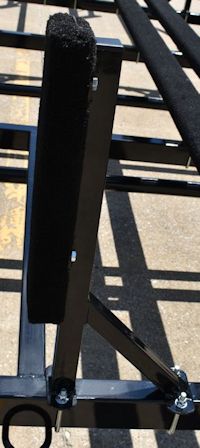
Spare Tire
When traveling, spare tires give you peace of mind knowing that if something does go wrong, youre covered. Our spare tires come with a U shaped bolt which secures to the front of our trailer for storage. Available in 12in for Light Duty Trailers, 13in for Regular Duty Trailers, and 14in for Heavy and Super Duty Trailers.
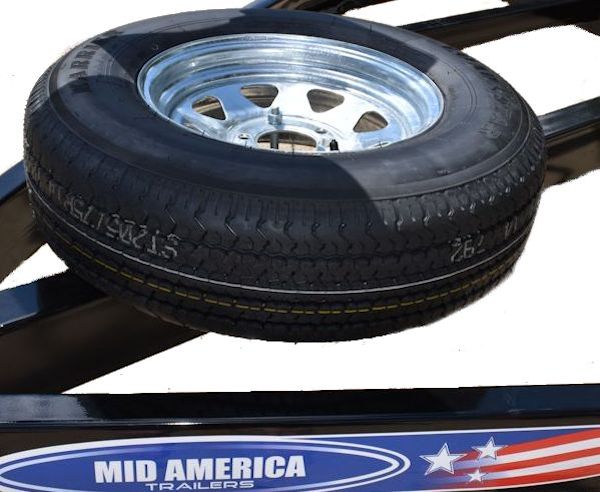
Tri-Tube Kit
Essential for any boat with a tri-toon, this tri-tube kit supports your center tune and comes with a winch stand that can hold a heavier load. Please let us know either the shape and length of your middle toon, or the year make and model of your boat as some boats have a longer middle tube and require a different type of tri-tune kit.

Plastic Wrapped Bunks
Plastic wrapped bunks are perfect if you will be repeatedly loading and launching your boat in and out of the water. Plastic wrapped bunks vs. carpeted bunks have a longer life because it is made of high impact plastic and it much stronger than carpet. For cost effective price, youll certainly want to upgrade. Price varies with trailer size.
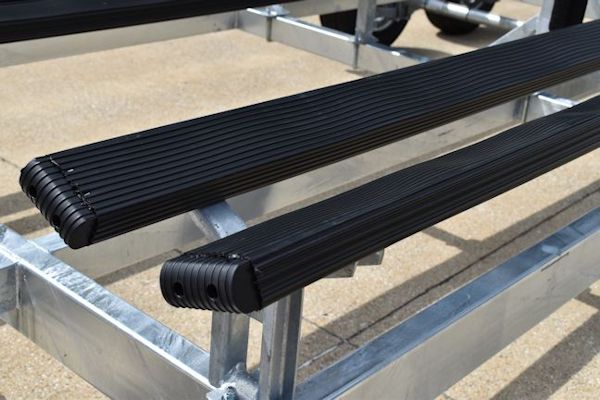
Dress-Up Kit
Make your trailer stand out with and aluminum plated diamond tread on all the steps, fenders, and frame! Not only does this addition make your trailer look pretty, but it reduces scratching and scuffing on these high traffic areas.

Galvanization
A must have for salt water applications, this keeps your pontoon trailer from rusting and extends the life of your springs in the drum brakes when being submerged in salt water. Different from other manufacturers who use galvanneal steel, we take the time and effort to dip your entire trailer into a vat of hot galvanizing solution to coat the pontoon trailer and bake it on. This dramatically reduces rusting and corrosion.
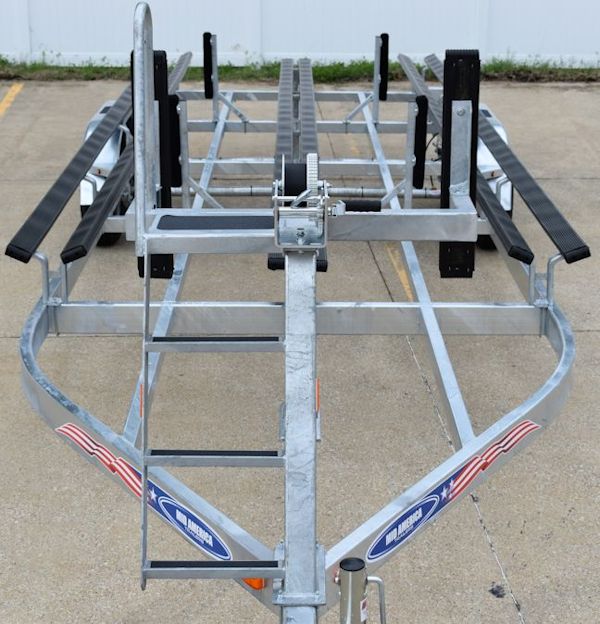
Disc Brakes
In most states, it is the law that any trailer with a 3,000 pound load or heavier (this includes the trailer, the boat, motor type/size, and anything in or on the boat) is required to have brakes on at least one axle. Purchasing your trailer with brakes is always a great idea, not just because of brake laws, but because when your towing such a heavy load brakes on your trailer make traveling easier and safer. When it comes down to the decision of whether you should get brakes on one axle, or brakes on two axels this will depend on a variety of things. How big is your boat? What kind of motor is on your boat? Is your boat a bi-toon or a tri-toon? How far and how often will you be traveling? When your traveling and your hauling a few thousand pounds behind you, if not equipped with brakes the haul can push or pull against you even if your vehicle is braking. A good way to look at it is your car/trucks brakes will help stop your car/truck, and your trailers brakes will help stop your trailer. Of course, if you have any questions at all please give us a call at 574.204.2345 and we will be happy to assist you. Some people use their pontoon trailer specifically for storing their boat or may have a mini pontoon and may decide they do not need brakes at all. This is solely your decision and most of our trailers can be purchased without brakes.

10 ft Wide Extension Kit
This Kit is necessary for those of you who have a newer pontoon that unlike most pontoons which are 8ft or 8ft 6in wide, have a 10ft wide pontoon. These are extension pieces that are added to the frame during manufacturing that allows us the adjust the bunks accordingly to accommodate your wider pontoon. This 10ft wide kit can only be purchased with your new trailer and cannot be added on later.
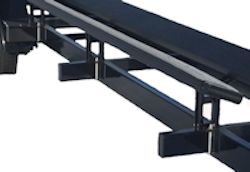
Stern Extension
This Stern Extension is for pontoons with longer transoms. Stern extensions help support the engine pod and fuel tank. They are needed because when traveling the engine and fuel weighs so much that the bouncing and vibration loosens the engine pod. Some pontoons that may need this are certain models of Bennington, Avalon, and Manitou.

Frequently Asked Questions and Answers!
Q: What is the advantage of disc brakes over drum brakes?
A: Disc brakes dissipate heat more effectively, which in turn helps prevent brake fading and lengthens the life span of your brakes. Disc brakes also operate better in wet environments such as in the rain or going through puddles, because they donâ€â„¢t have the same risk of holding water as drum brakes do.
Q: What is a leaf spring, and what do they do?
A: A leaf spring is a form of spring that is used for the suspension in vehicles. Sometimes referred to as semi-elliptical springs or cart springs, a leaf spring is an arc-shape, slender piece of steel that is stacked with the same material in smaller sizes and bolted together creating a reinforced bow-like item. It is then attached to the rear axle and the chassis providing support to any additional weight that is added to a vehicle, preventing the axle from buckling in and snapping from the pressure of an extreme amount of weight that it was not originally designed to carry. The overall purpose of a leaf spring is to provide support for a vehicle. It also provides for a smoother ride absorbing any bumps or potholes in the road. Leaf springs are also used to locate the axle and control the height at which the vehicle rides and helps keep the tires aligned on the road.
Q: What is the difference between galvanized steel and galvannealed steel?
A: Galvannealed and galvanized steel are zinc coated at the steel mills and are designed for rust and corrosion resistance. Both steels are passed through a hot dip coating process for rust prevention. Galvannealed Steel - zinc-iron alloy-coated by the hot-dip process followed by heating the steel to induce diffusion alloying between the molten zinc coating and the steel. The resulting finish is a dull matte surface. Galvanized Steel - zinc-coated by the hot-dip process, resulting in a full spangled finish. Both are extremely affective, but we use and prefer Galvanized steel.
Q: Which is better, 14 gauge steel or 11 gauge steel?
A: 11 gauge steel is thicker than 14 gauge steel, so it is capable of supporting a heavier load. 11 gauge is approximately 1/8th of an inch whereas 14 gauge is only about 5/64ths of an inch.
| Number of Gauge | Approximate thickness by Inch | Approximate thickness by Millimeters |
| 10 Gauge | 9/64 | 3.572 |
| 11 Gauge | 1/8 | 3.175 |
| 12 Gauge | 7/64 | 2.778 |
| 13 Gauge | 3/32 | 2.381 |
| 14 Gauge | 5/64 | 1.984 |
Q: What is the benefits of radial tires vs bias ply tires?
A: Radial tires are constructed with perpendicular polyester plies and crisscrossing steel belts underneath the tread. This gives the driver a smoother as it will absorb the shock of bumps in the road and extend the life of the tire. Radial tires also allow the trailer to transfer more power to the ground because of the wider tread which reduces fuel consumption. A bias ply tireâ€â„¢s construction consists of internally crisscrossing nylon cord plies, which makes the tire more prone to over heating.
Finding the Correct Trailer Size for Your Pontoon Boat



